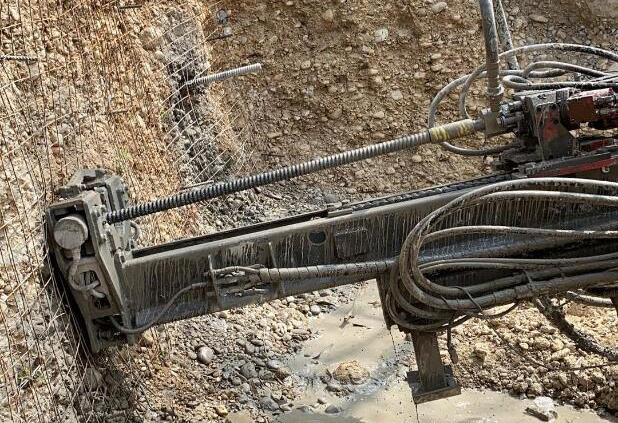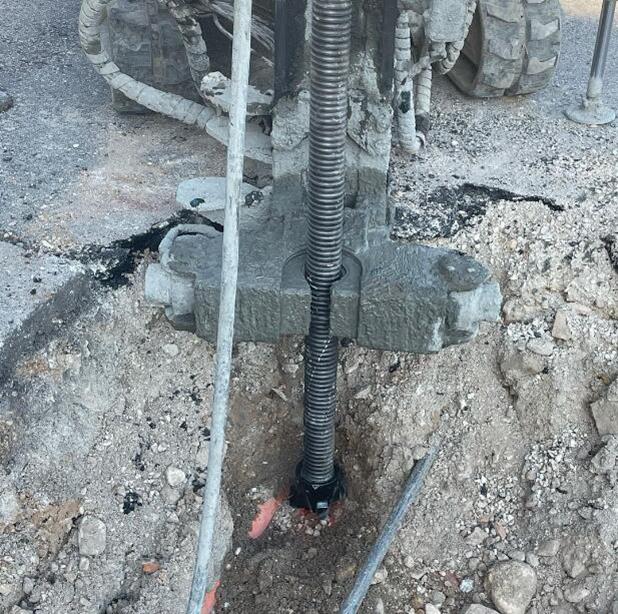Self-Drilling Anchor bolts are a combined system of rock bolt, drill bit and other accessories. During drilling, the bolts is used as the drill rod fixed with a drill bit, rod and bit remain in the hole as a rock bolt, which is grouted through the flushing hole. In case of collapsing boreholes, this system still enables the installation of rock bolts for very common flexible rock support to anchor the fractured rock mass in the tunnel and gives the strength and stability to the ground.

Use: Self-Drilling Rock Bolt is a rock-bolting system based on fully coarse threaded hollow bar. It is especially recommended for the following applications:
•Roof and wall bolting as a temporary support in tunnels.
• All ground conditions. Self-Drilling Rock Bolts do not require pre-drilling a hole, therefore making it usable even in soft rock conditions.
• Self-drilling bolts shall be used in ground conditions where the effective installation of other types of rock bolts is impossible.
• For loose ground/ fractured rock conditions, where drill holes collapses immediately during the drilling, the Self Drilling Anchors can provide immediate stabilization of the opening.
• It shall be grouted through the flushing hole immediately after completion of the drilling operation or simultaneously with the drilling as required.
Installation Procedure:
• Drilling, grouting, and anchoring, in one operation. The hollow steel anchor rod also acts as a grouting pipe to ease set up.
Design Considerations and Specifications:
• The ground is a vital element of the ground anchor system; therefore a good quality geotechnical investigation is essential. Various parameters to be considered during geotechnical investigations should include Classification of rocks (Geometry of discontinuities, unit weight, degree of weathering, Index test), Rock stratification, Unconfined compression strength of intact rock, Shear strength and deformability of rock mass, Permeability, Ground water conditions, Corrosion potentials of rock and ground water etc.
• Moreover, the design of the anchor system is based on rock parameters and the geometry of the anchor arrangement. Where changes in the anchor locations, spacing’s or inclinations are proposed, appropriate studies or proving tests should be undertaken to demonstrate the suitability of such an arrangement.

The design of the anchor should consider the following:
• Loads and constraints of loading imposed by the anchors on the overall structure
• The way in which the loads will be applied to the anchor during its designed life i.e. static or dynamic
• The load distribution of the anchor arrangement on the structure during stressing and during the design life of the structure
• The interface between the anchor and the structure to ensure structural stability
• The consequence of anchor failure during stressing and thereafter. The diameter and tensile strength of bolt and also arrangement (number, spacing etc.) of rock bolts to be used may vary according to design and site requirements. The diameter of rock bolts depend on the mass of the rock to be supported by each rock bolt and the force of resisting shear in the bedrock.
•EN 1997-1 – Geotechnical Design-Part 1: General Rules and BS EN 1537-2000- Execution of Special Geotechnical work- Ground Anchors may be followed for all geotechnical designs, installation of Ground Anchors. DIN 1054:2005-01 – Ground verification of the Safety of Earthworks and Foundations IS is also being used for geotechnical designs for ground anchors.
• Generally, Self-drilling Anchors/bolts having minimum diameter 32 mm with a minimum yield load of 200 kN are used for Rock bolting/ Face bolting as a temporary support in tunnels.
• Adverse interactions of anchorages should be avoided, by keeping a space not less than 1.5 m between them, if possible.
• The yield loads of the bolt get transferred through thread to nut, washer, anchor plate and coupling etc. Hence, these should also be designed accordingly. The rolled thread should be in accordance with ISO 10208.
• Manufacturing of Self-drilling Anchors should conform to BS EN-10083-1 “Steels for quenching and tempering - Part 1: General technical delivery conditions”.
• For all types of Self-drilling Anchors, the anchor head shall be designed in accordance to EN 1537:1999, and should be able to accommodate deformations, which may occur during the design life of the structure.
• Corrosion protection of Self-drilling Anchors should comply with Para 6.9 of EN 1537:1999 as required.
• Tensile test of Self-drilling Anchors is done in accordance to EN 10002-1. The test involves straining a test piece in tension, generally to fracture, for the purpose of determining one or more of the mechanical properties i.e. percentage elongation, tensile strength, yield strength, upper yield strength etc.
• Impact test of Self-drilling Anchors should be done is done in accordance to EN 10045-1. The test consists of breaking by one blow from a swinging pendulum, under conditions defined in code above. The energy absorbed is a measure of the impact strength of the material.
• Pull out test on Self-drilling Anchors should be performed of on the basis of IS: 11309 – Method for conducting Pull-Out Test on Anchor Bars and Rock Bolts. - Minimum three pull out tests shall be conducted in one rock formation as mentioned in clause 4.8 of IS: 11309-1985 or as per the instructions of Engineer-in-charge.
Note: All information comes from the Internet, please contact delete if it is inappropriate.


